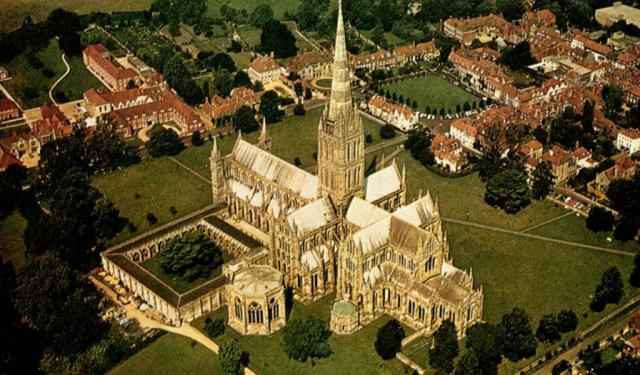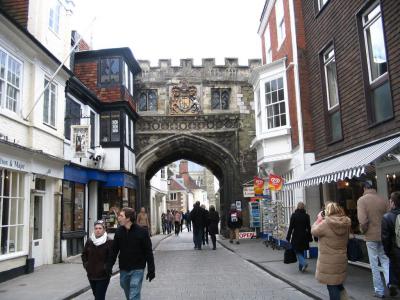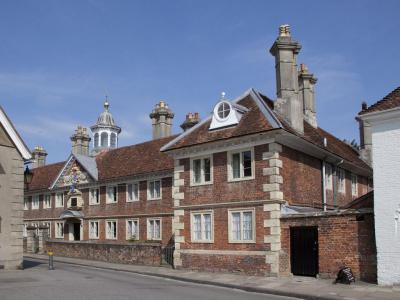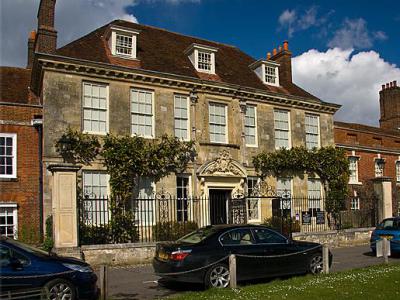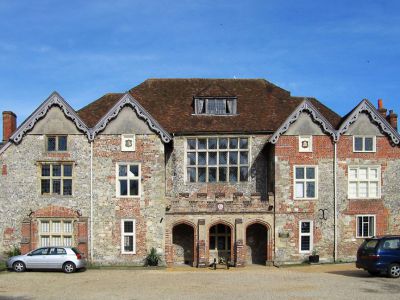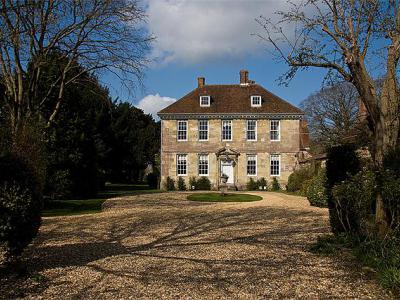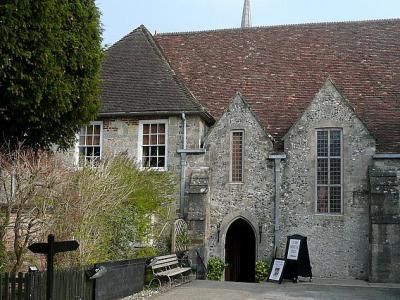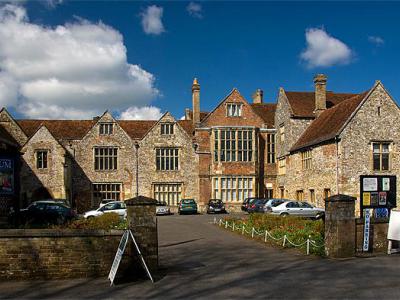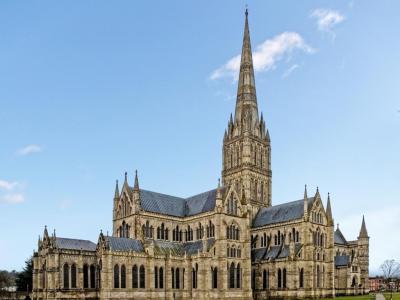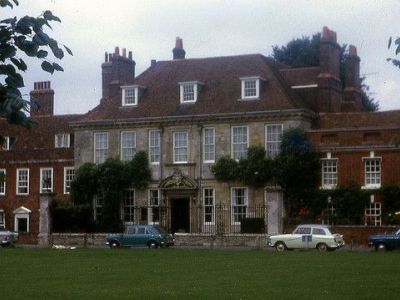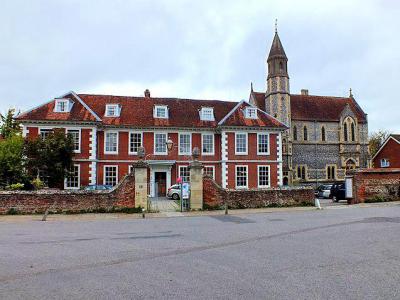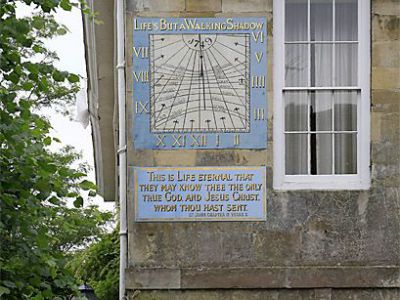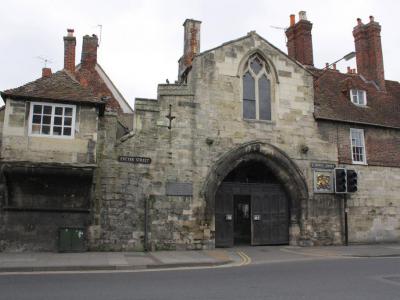Cathedral Close Tour (Self Guided), Salisbury
Salisbury Cathedral, apart from being renowned as the holder of Britain’s tallest spire, the world’s best preserved original copy of Magna Carta (1215) and Europe’s oldest working clock, is also famous for its Close, the largest in the country, measuring 80 acres (or 32 hectares).
The areas surrounding cathedrals' grounds, sometimes extending for hundreds of meters from the main building, were rather commonplace in Medieval Europe. Such territory normally had gates that were locked at night or during unrest in the city, hence the name “Close”. It usually included buildings housing diocesan offices, schools, free-standing chapels, and the palace of the bishop and other clergy houses associated with the cathedral.
Sometimes, but not necessarily so, the territory was arranged in a sort of square around a courtyard, as is the case of Salisbury Cathedral. Laid out in 1220, the Cathedral's Close offers a marvelous setting for it, reflecting architectural styles spanning 800 years.
Here, alongside spacious lawns and shady trees, making for a pleasant break from the busy streets of the city, you will find 21 listed buildings, a couple of museums and a number of gardens, all steeped in history. Several buildings within the Close are open to the public; others you can only stand by and look at through the wrought-iron railings and admire their moss-covered gabled roofs, mullioned windows and beautiful gardens.
Among the particularly notable attractions here are: High Street Gate, built between 1327 and 1342, located next to the College of Matrons (1682); Mompesson House, featured in the award-winning movie “Sense and Sensibility”; The Rifles (Berkshire & Wiltshire) Museum; Arundells, home of the former UK Prime Minister Sir Edward Heath; and several other buildings.
To discover more about the Salisbury Cathedral Close landmarks and appreciate their stunning architecture and craftsmanship, take this self-guided walking tour.
The areas surrounding cathedrals' grounds, sometimes extending for hundreds of meters from the main building, were rather commonplace in Medieval Europe. Such territory normally had gates that were locked at night or during unrest in the city, hence the name “Close”. It usually included buildings housing diocesan offices, schools, free-standing chapels, and the palace of the bishop and other clergy houses associated with the cathedral.
Sometimes, but not necessarily so, the territory was arranged in a sort of square around a courtyard, as is the case of Salisbury Cathedral. Laid out in 1220, the Cathedral's Close offers a marvelous setting for it, reflecting architectural styles spanning 800 years.
Here, alongside spacious lawns and shady trees, making for a pleasant break from the busy streets of the city, you will find 21 listed buildings, a couple of museums and a number of gardens, all steeped in history. Several buildings within the Close are open to the public; others you can only stand by and look at through the wrought-iron railings and admire their moss-covered gabled roofs, mullioned windows and beautiful gardens.
Among the particularly notable attractions here are: High Street Gate, built between 1327 and 1342, located next to the College of Matrons (1682); Mompesson House, featured in the award-winning movie “Sense and Sensibility”; The Rifles (Berkshire & Wiltshire) Museum; Arundells, home of the former UK Prime Minister Sir Edward Heath; and several other buildings.
To discover more about the Salisbury Cathedral Close landmarks and appreciate their stunning architecture and craftsmanship, take this self-guided walking tour.
How it works: Download the app "GPSmyCity: Walks in 1K+ Cities" from Apple App Store or Google Play Store to your mobile phone or tablet. The app turns your mobile device into a personal tour guide and its built-in GPS navigation functions guide you from one tour stop to next. The app works offline, so no data plan is needed when traveling abroad.
Cathedral Close Tour Map
Guide Name: Cathedral Close Tour
Guide Location: England » Salisbury (See other walking tours in Salisbury)
Guide Type: Self-guided Walking Tour (Sightseeing)
# of Attractions: 12
Tour Duration: 1 Hour(s)
Travel Distance: 1.2 Km or 0.7 Miles
Author: Sandra
Sight(s) Featured in This Guide:
Guide Location: England » Salisbury (See other walking tours in Salisbury)
Guide Type: Self-guided Walking Tour (Sightseeing)
# of Attractions: 12
Tour Duration: 1 Hour(s)
Travel Distance: 1.2 Km or 0.7 Miles
Author: Sandra
Sight(s) Featured in This Guide:
- High Street Gate
- Matrons' College
- Mompesson House
- The Rifles Museum
- Arundells
- Medieval Hall & Old Deanery
- Salisbury Museum
- Salisbury Cathedral
- The Bishop's Palace
- Sarum College
- Malmesbury House
- Saint Ann's Gate & Cathedral Close Walls
1) High Street Gate
As one of the original five gateways into Salisbury’s old city wall, the North Gate has been the historic pass-through to the High Street and beyond since it was built in the 14th century. A sturdy blend of rubble stone and ashlar, it once housed a small jail for local lawbreakers-ideal if you wanted your miscreants securely locked up without having to haul them too far. Mostly designed for pedestrians back in the day, the narrow arch isn’t exactly welcoming to modern cars.
The gate has seen its share of tweaks over the centuries: a portcullis added and later removed, extra windows popped in, a new roof, and a door installed on the Porters Lodge in the 1600s. That lodge wasn’t just a functional workspace, either-it was a plum job for a well-connected servant or noble’s retainer. By 1950, the gatehouse was converted into an office for the Cathedral clerk of works and remains an active office space today.
As you walk through, take a moment to admire the details. On the city side, the Stuart royal coat of arms from the 17th century adds a regal flourish, while on the opposite side, a statue of Edward VII, added in 1902, quietly keeps watch over this ancient gateway to Salisbury’s High Street.
The gate has seen its share of tweaks over the centuries: a portcullis added and later removed, extra windows popped in, a new roof, and a door installed on the Porters Lodge in the 1600s. That lodge wasn’t just a functional workspace, either-it was a plum job for a well-connected servant or noble’s retainer. By 1950, the gatehouse was converted into an office for the Cathedral clerk of works and remains an active office space today.
As you walk through, take a moment to admire the details. On the city side, the Stuart royal coat of arms from the 17th century adds a regal flourish, while on the opposite side, a statue of Edward VII, added in 1902, quietly keeps watch over this ancient gateway to Salisbury’s High Street.
2) Matrons' College
The College of Matrons (or Matrons' College) is a residential building and charity within the Salisbury Cathedral Close. It was constructed in 1682 by Seth Ward as an almshouse (permanent residence) for ten widows of clergy ordained within the diocese of Salisbury.
Originally, applicants to the college had to be widows with adequate funds, who were over 50 years of age, sober-minded and religious. Among the early rules of governance, tenants were required to attend two divine services a day in the cathedral and must not be absent from the Close for more than a month. Presently, the charitable Matron's College caters to local single women.
The college building – there is some uncertainty about its being designed by Christopher Wren – has a striking crest of arms on the exterior. Built of brick, it has stone window surrounds, stone quoining and red tiles.
Above the porched main entrance, set in a roof level gable end, is a brightly painted Royal Coat of Arms from the Stuart period, with drapes of fruit on each side. There is also a garden area to the rear and some other smaller associated redbrick buildings. The main edifice was extended and renovated in 1870.
Originally, applicants to the college had to be widows with adequate funds, who were over 50 years of age, sober-minded and religious. Among the early rules of governance, tenants were required to attend two divine services a day in the cathedral and must not be absent from the Close for more than a month. Presently, the charitable Matron's College caters to local single women.
The college building – there is some uncertainty about its being designed by Christopher Wren – has a striking crest of arms on the exterior. Built of brick, it has stone window surrounds, stone quoining and red tiles.
Above the porched main entrance, set in a roof level gable end, is a brightly painted Royal Coat of Arms from the Stuart period, with drapes of fruit on each side. There is also a garden area to the rear and some other smaller associated redbrick buildings. The main edifice was extended and renovated in 1870.
Sight description based on Wikipedia.
3) Mompesson House (must see)
Step into this Grade I listed gem, now under the care of the National Trust. Built in classic Queen Anne style and clad in the very same Chilmark stone used for Salisbury Cathedral, the house was commissioned by Sir Thomas Mompesson-MP for Salisbury three times over-and completed in 1701 by his son Charles. Even the cartouche over the front door is a replica of Charles and his wife Elizabeth’s coat of arms, lending a personal touch to the elegant facade.
Eventually, Charles’ brother-in-law took charge, adding a striking oak staircase and elaborate plaster detailing. The home then passed through a series of tenants-most famously Barbara Townsend, who called it home for nearly a century and famously resisted any 20th-century conveniences. By 1975, the house was in the hands of the National Trust: nearly empty, yet brimming with historical charm.
Today, it is fully furnished and features a prized collection of 18th-century drinking glasses, alongside fine porcelain and period furniture from the 18th and 19th centuries. Regular events and exhibitions add even more to the experience. Be sure to wander through the intimate enclosed garden, and don’t miss the tea room at the bottom. It’s the perfect spot to reflect on this little slice of Salisbury’s history.
Eventually, Charles’ brother-in-law took charge, adding a striking oak staircase and elaborate plaster detailing. The home then passed through a series of tenants-most famously Barbara Townsend, who called it home for nearly a century and famously resisted any 20th-century conveniences. By 1975, the house was in the hands of the National Trust: nearly empty, yet brimming with historical charm.
Today, it is fully furnished and features a prized collection of 18th-century drinking glasses, alongside fine porcelain and period furniture from the 18th and 19th centuries. Regular events and exhibitions add even more to the experience. Be sure to wander through the intimate enclosed garden, and don’t miss the tea room at the bottom. It’s the perfect spot to reflect on this little slice of Salisbury’s history.
4) The Rifles Museum
Located in Salisbury’s historic Cathedral Close, the Rifles Museum offers a comprehensive exploration of the distinguished histories of the Royal Berkshire and Wiltshire Regiments. The museum is housed in “The Wardrobe,” a building dating back to the 13th century that once served as a storage space for the Bishop of Salisbury’s robes and ecclesiastical gear. Within this historic setting, visitors can explore over two and a half centuries of military service.
Founded in 1982 and inaugurated by the Duke of Edinburgh, the museum showcases the experiences of soldiers who served in conflicts from the Seven Years’ War to more recent engagements in Afghanistan. Exhibits include a wealth of artifacts, personal memorabilia, and detailed displays that shed light on the valor and everyday lives of the infantrymen. The collection provides insight into major campaigns, such as the Peninsular War, the Crimean War, the Boer War, and both World Wars.
Beyond its indoor exhibits, the museum offers a peaceful riverside garden as a quiet spot for reflection, while The Rifleman’s Table café, situated nearby, serves homemade meals, lunches, and traditional cream teas during the summer, enhancing the overall visit.
As of 2025, the museum is undergoing a major redevelopment of its galleries, with a reopening planned for April. Visitors are encouraged to visit the museum’s website for updates on reopening dates and upcoming events.
Founded in 1982 and inaugurated by the Duke of Edinburgh, the museum showcases the experiences of soldiers who served in conflicts from the Seven Years’ War to more recent engagements in Afghanistan. Exhibits include a wealth of artifacts, personal memorabilia, and detailed displays that shed light on the valor and everyday lives of the infantrymen. The collection provides insight into major campaigns, such as the Peninsular War, the Crimean War, the Boer War, and both World Wars.
Beyond its indoor exhibits, the museum offers a peaceful riverside garden as a quiet spot for reflection, while The Rifleman’s Table café, situated nearby, serves homemade meals, lunches, and traditional cream teas during the summer, enhancing the overall visit.
As of 2025, the museum is undergoing a major redevelopment of its galleries, with a reopening planned for April. Visitors are encouraged to visit the museum’s website for updates on reopening dates and upcoming events.
5) Arundells (must see)
Originally built around 1291 as a canonry, this historic house comes with a splash of medieval intrigue-its last canon, Leonard Bilson, found himself behind bars in 1562, accused of dabbling in magic and sorcery. Since then, the building has been repeatedly reimagined, each century adding another twist to its story.
The current Georgian facade is the handiwork of John Wyndham, who called it home from 1718 to 1750. The house gained its “Arundells” name when James Arundell, son of Lord Arundell, moved in from 1752 to 1803. By the 19th century, it became a school, later serving as a library and wool depot during World War II. After the war, it fell into disrepair until a 1964 restoration brought it back to life.
The most notable resident, however, was Sir Edward Heath, who bought Arundells in 1985. The former British Prime Minister ( from 1970–1974) lived here until his death, turning it into a vibrant social hub. Hosting esteemed guests and grand parties, he filled the house with his favorite things: an impressive art collection featuring political cartoons, paintings by Winston Churchill, and works by Augustus John, LS Lowry, and John Singer-Sargent. A Steinway grand piano and Lloyd George’s writing desk add gravitas, but the quirky touches-like the “teapot” chair for enjoying music-reveal his personal side.
Today, Arundells is preserved much as it was during Sir Edward’s lifetime. With beautifully landscaped gardens that sweep down to the River Avon, it’s a delightful glimpse into a storied past filled with music, sailing, politics, and more than a few colorful characters.
The current Georgian facade is the handiwork of John Wyndham, who called it home from 1718 to 1750. The house gained its “Arundells” name when James Arundell, son of Lord Arundell, moved in from 1752 to 1803. By the 19th century, it became a school, later serving as a library and wool depot during World War II. After the war, it fell into disrepair until a 1964 restoration brought it back to life.
The most notable resident, however, was Sir Edward Heath, who bought Arundells in 1985. The former British Prime Minister ( from 1970–1974) lived here until his death, turning it into a vibrant social hub. Hosting esteemed guests and grand parties, he filled the house with his favorite things: an impressive art collection featuring political cartoons, paintings by Winston Churchill, and works by Augustus John, LS Lowry, and John Singer-Sargent. A Steinway grand piano and Lloyd George’s writing desk add gravitas, but the quirky touches-like the “teapot” chair for enjoying music-reveal his personal side.
Today, Arundells is preserved much as it was during Sir Edward’s lifetime. With beautifully landscaped gardens that sweep down to the River Avon, it’s a delightful glimpse into a storied past filled with music, sailing, politics, and more than a few colorful characters.
6) Medieval Hall & Old Deanery
Concealed from the road by a modern college block, the Old Deanery building, situated opposite the west end of the Cathedral, was probably one of the first sites to be developed within the Close, circa 1220. In 1277, Bishop Roger de Wykehampton made over the Hall, that he had occupied as Dean, to be used as the Deanery. Ever since then and for another 700+ years, until 1922, it had served as the primary accommodations for Deans, following which it became part if the diocesan training college of Sarum St Michael.
Back in the 13th century, the property comprised an open hall with service rooms, a cross range and a chapel. It was enlarged during the late 14th or early 15th century, and further restored in 1670. Another, partial reconstruction took place in the second half of the 18th century, with further alterations followed in the early 19th century. The building was once again restored throughout 1960-63, and in 1981 was turned into a block of flats.
Today, the Deanery complex encompasses three medieval houses along the River Avon, which are in perfect condition courtesy of extensive restorations, the most recent one being in 1995. Inside the Medieval Banqueting Hall, underneath a timber-framed roof supported by stone walls, you will find the High Table, the old hearth and original 13th-century wall painting. Also in the Hall, from April to September, a 30-minute video on Salisbury’s history, called 'Secrets of Salisbury,' is demonstrated every hour.
Back in the 13th century, the property comprised an open hall with service rooms, a cross range and a chapel. It was enlarged during the late 14th or early 15th century, and further restored in 1670. Another, partial reconstruction took place in the second half of the 18th century, with further alterations followed in the early 19th century. The building was once again restored throughout 1960-63, and in 1981 was turned into a block of flats.
Today, the Deanery complex encompasses three medieval houses along the River Avon, which are in perfect condition courtesy of extensive restorations, the most recent one being in 1995. Inside the Medieval Banqueting Hall, underneath a timber-framed roof supported by stone walls, you will find the High Table, the old hearth and original 13th-century wall painting. Also in the Hall, from April to September, a 30-minute video on Salisbury’s history, called 'Secrets of Salisbury,' is demonstrated every hour.
7) Salisbury Museum (must see)
The Salisbury Museum (previously known as The Salisbury and South Wiltshire Museum) houses one of the best collections relating to Stonehenge and local archaeology. The museum itself is housed in The King's House, a historic building where King James I of England was entertained in 1610 and 1613. Set in the surroundings of the Salisbury Cathedral Close, the museum faces the west front of the Cathedral.
The original three-storey edifice with mullioned and transom windows, ornate plaster ceilings and a fine oak-balustraded staircase, contains the main exhibition gallery with the ceramics gallery above. The arms of James I's eldest son, Henry Frederick, Prince of Wales, can be seen in a window in the Wedgewood gallery upstairs.
In the summer of 2014, the Museum had a new gallery added, recounting the history of Salisbury and the surrounding area, from prehistoric times until the Norman Conquest, and highlighting the city's unique place in history. On display there are some of the most important archaeological finds in Britain, such as artefacts from the Stonehenge World Heritage Site, the Pitt Rivers Wessex Collection and the Amesbury Archer.
The Museum boasts a lavish art collection comprising over 4,000 paintings, prints and drawings, representing local personalities, topographical scenes, special events and everyday life, created by local artists of note. Among these are a number of images of Stonehenge, including a watercolour by JMW Turner.
The outstanding Costume Collection showcases items of clothing, such as wedding dresses, uniforms, formal wear and lace samples produced by Downton Lace, worn by people in and around Salisbury in the past 250 years.
The Museum also has a remarkable collection of ceramics, featuring local Verwood and Wiltshire Brown ware alongside celebrated Wedgwood, Bow and Chelsea potteries. There is also a collection of locally-made cutlery.
The original three-storey edifice with mullioned and transom windows, ornate plaster ceilings and a fine oak-balustraded staircase, contains the main exhibition gallery with the ceramics gallery above. The arms of James I's eldest son, Henry Frederick, Prince of Wales, can be seen in a window in the Wedgewood gallery upstairs.
In the summer of 2014, the Museum had a new gallery added, recounting the history of Salisbury and the surrounding area, from prehistoric times until the Norman Conquest, and highlighting the city's unique place in history. On display there are some of the most important archaeological finds in Britain, such as artefacts from the Stonehenge World Heritage Site, the Pitt Rivers Wessex Collection and the Amesbury Archer.
The Museum boasts a lavish art collection comprising over 4,000 paintings, prints and drawings, representing local personalities, topographical scenes, special events and everyday life, created by local artists of note. Among these are a number of images of Stonehenge, including a watercolour by JMW Turner.
The outstanding Costume Collection showcases items of clothing, such as wedding dresses, uniforms, formal wear and lace samples produced by Downton Lace, worn by people in and around Salisbury in the past 250 years.
The Museum also has a remarkable collection of ceramics, featuring local Verwood and Wiltshire Brown ware alongside celebrated Wedgwood, Bow and Chelsea potteries. There is also a collection of locally-made cutlery.
Sight description based on Wikipedia.
8) Salisbury Cathedral (must see)
At Salisbury’s Cathedral, superlatives flock together like birds on a wire. The tallest spire in Britain? Check: 404 feet. One of only four original copies of the Magna Carta-preserved better than a mummy in a museum? Check. The oldest working clock in Europe, ticking since 1386? Check again. Add to that the largest cathedral cloisters, the biggest cathedral close in Britain, the earliest complete set of choir stalls, and the highest vault in the land. It’s a record-breaking masterpiece, built in just 38 years, from 1220 to 1258-no cranes, no bulldozers, just raw medieval ingenuity.
What set Salisbury Cathedral apart is that it was built on a fresh, empty site. No ruins to work around, no half-finished foundations. The builders had a blank canvas and a clear plan, creating a cohesive design that tied the entire complex together. Begun just five years after the main cathedral was finished, the cloisters mirrored its style with pointed arches, elegant patterns, and matching materials. It was the big debut of Early English Gothic architecture, using narrow stone piers instead of chunky rubble-filled columns. The result was a lighter, brighter interior that let the sun pour in through those lancet windows.
Sure, the structure had its share of “makeovers” over the centuries. James Wyatt and Sir George Gilbert Scott could not resist tweaking things, and some original decorations and chapels did not survive. But Salisbury’s graceful lines and clean symmetry remain intact-still polished, still stunning.
Outside, the cathedral close is now a serene, green expanse. The gravestones are gone, leaving open lawns with benches and shade trees where visitors can picnic or simply admire the view. Just remember, no bikes, booze, ball games, or drones. Instead, enjoy the occasional outdoor art exhibit, or just take in the tranquil atmosphere. It’s history, beauty, and a touch of peace, all wrapped up in one iconic site.
What set Salisbury Cathedral apart is that it was built on a fresh, empty site. No ruins to work around, no half-finished foundations. The builders had a blank canvas and a clear plan, creating a cohesive design that tied the entire complex together. Begun just five years after the main cathedral was finished, the cloisters mirrored its style with pointed arches, elegant patterns, and matching materials. It was the big debut of Early English Gothic architecture, using narrow stone piers instead of chunky rubble-filled columns. The result was a lighter, brighter interior that let the sun pour in through those lancet windows.
Sure, the structure had its share of “makeovers” over the centuries. James Wyatt and Sir George Gilbert Scott could not resist tweaking things, and some original decorations and chapels did not survive. But Salisbury’s graceful lines and clean symmetry remain intact-still polished, still stunning.
Outside, the cathedral close is now a serene, green expanse. The gravestones are gone, leaving open lawns with benches and shade trees where visitors can picnic or simply admire the view. Just remember, no bikes, booze, ball games, or drones. Instead, enjoy the occasional outdoor art exhibit, or just take in the tranquil atmosphere. It’s history, beauty, and a touch of peace, all wrapped up in one iconic site.
9) The Bishop's Palace
The Bishop’s Palace is one of Salisbury's oldest buildings, yet not all that well-known. Hidden behind tall walls and gates, with only faint glimpses of stonework seen through the trees planted in front of it, it is presently better known as Salisbury Cathedral School. Access to the grounds is limited to students and staff, with only rare openings to the public.
The property was started around 1219, around the same time as the cathedral itself, by Bishop Richard Poore to become his first residence (as well as the first edifice erected within The Close). It was initially, and rather unimaginatively so, referred to as 'New Place'. The original building, rather simple, was later added to and altered by subsequent bishops until it gained its present form – a series of irregular structures – the most striking of which is the tower with crenallated turret resulted from a large overhaul in the late 15th or early 16th century.
A 15th-century bedchamber was converted into a Tudor chapel in the mid-16th century (first documented in 1588). Parts of the palace were demolished after 1648, with the surviving elements converted into an inn and tenements. Fragment of the original building has survived in the vaulted undercroft, known as Bishop Poore's Hall. Restored by Bishop Wordsworth in 1889, it was used by Bishop Wordsworth School.
During the Commonwealth period, from 1649 to 1660, the palace was let out in tenements, one of which was kept as an inn by a Dutch tailor. After these depredations the house was completely restored by Bishop Seth Ward. The gardens were laid out and a lake formed in the mid-19th century, at which time the stables and an entrance lodge were added.
Parts of the property were demolished in 1931, and in 1947 the Church Commissioners exchanged the palace with the dean and chapter for Mompesson House. The palace then became the premises of the Cathedral School, and the bishop moved his residence, for a time, to Mompesson House.
Presently, displayed inside the palace is a collection of portraits of all the Bishops of Salisbury.
The property was started around 1219, around the same time as the cathedral itself, by Bishop Richard Poore to become his first residence (as well as the first edifice erected within The Close). It was initially, and rather unimaginatively so, referred to as 'New Place'. The original building, rather simple, was later added to and altered by subsequent bishops until it gained its present form – a series of irregular structures – the most striking of which is the tower with crenallated turret resulted from a large overhaul in the late 15th or early 16th century.
A 15th-century bedchamber was converted into a Tudor chapel in the mid-16th century (first documented in 1588). Parts of the palace were demolished after 1648, with the surviving elements converted into an inn and tenements. Fragment of the original building has survived in the vaulted undercroft, known as Bishop Poore's Hall. Restored by Bishop Wordsworth in 1889, it was used by Bishop Wordsworth School.
During the Commonwealth period, from 1649 to 1660, the palace was let out in tenements, one of which was kept as an inn by a Dutch tailor. After these depredations the house was completely restored by Bishop Seth Ward. The gardens were laid out and a lake formed in the mid-19th century, at which time the stables and an entrance lodge were added.
Parts of the property were demolished in 1931, and in 1947 the Church Commissioners exchanged the palace with the dean and chapter for Mompesson House. The palace then became the premises of the Cathedral School, and the bishop moved his residence, for a time, to Mompesson House.
Presently, displayed inside the palace is a collection of portraits of all the Bishops of Salisbury.
10) Sarum College
Sarum College is a centre of theological learning, focused on the study of Christianity. Its main, red-brick building, located at the north end of Bishop's Walk, facing directly down to the Bishop's Palace, has long been attributed to Sir Christopher Wren. The house was built in 1677 for Francis Hill, a distinguished London lawyer and deputy recorder for Salisbury, and remained in the Hills' possession until the end of the 18th century.
In 1860, the property was acquired by a Bishop of Salisbury, who set up on premises a theological college. Residential areas were added later; the flint extension was made in 1881 with a chapel and library. The building has been altered several times over the years, including the addition of new residential quarters and meeting rooms.
In February 1952 the main building received a heritage listing. It had been occupied by Salisbury and Wells Theological College until 1995, following which the Sarum College took over.
The college building, in addition to providing space for theological classes, serves as a conference center. It also hosts art exhibitions which are open to the public every day from 9 am to 5 pm (10 am – 4 pm on Sundays), has regular lunchtime musical concerts, as well as a theological bookshop and library with a collection of 35,000 titles.
In addition to that, the college operates as a B&B and also hosts week-long residential stays, allowing visitors the opportunity to live in the Close for a week and explore the history of Salisbury and its Cathedral in more detail.
In 1860, the property was acquired by a Bishop of Salisbury, who set up on premises a theological college. Residential areas were added later; the flint extension was made in 1881 with a chapel and library. The building has been altered several times over the years, including the addition of new residential quarters and meeting rooms.
In February 1952 the main building received a heritage listing. It had been occupied by Salisbury and Wells Theological College until 1995, following which the Sarum College took over.
The college building, in addition to providing space for theological classes, serves as a conference center. It also hosts art exhibitions which are open to the public every day from 9 am to 5 pm (10 am – 4 pm on Sundays), has regular lunchtime musical concerts, as well as a theological bookshop and library with a collection of 35,000 titles.
In addition to that, the college operates as a B&B and also hosts week-long residential stays, allowing visitors the opportunity to live in the Close for a week and explore the history of Salisbury and its Cathedral in more detail.
Sight description based on Wikipedia.
11) Malmesbury House
Tucked away beside St. Ann’s Gate, to the east of The Close, Malmesbury House is an outstanding historic property constructed around 1416 on the site of Copt Hall, a 13th-century canonry.
At the outset of the Civil War, Sir George Vaughan, High Sheriff of Wiltshire, lived in this house from where he raised forces in the county to support King Charles I. The latter's son, King Charles II, also stayed in the house in 1665 when he fled London to escape the Great Plague, and is thought to have addressed the local public from the projecting oriel window which still overlooks St. John Street and bears his coat of arms. King Charles II was also reputed to have been hidden in this place after the disastrous battle of Worcester; one of the bedrooms herein is called “King Charles Room”.
The Harris family, who acquired the property in 1660, had the most influence on its appearance, a classic example of Queen Anne-style with a striking façade of ashlar and a steep pitched hipped tile roof. James Harris added the western portion of the house, while the frontage decorations were carried out by his son, James Harris II, in the 1740s. In turn, his own son and heir, James Harris III, was responsible for decorating the interior.
It is to James Harris III, who was created the 1st Earl of Malmesbury in recognition of his long and distinguished diplomatic career, that the house owes its name. James Harris III was a great lover of music and a friend of the composer George Frederick Handel who reportedly gave his first concert in England in the music room above St. Ann’s Gate; he also frequently stayed at this place.
The building's west front is attributed to Sir Christopher Wren although some believe that it may have been designed by the local architect, John Fort, Wren’s master builder.
The house has a remarkable blue and gold vertical sundial that was put in place in 1749, just three years before the reformation of the calendar in 1752. The sundial is partially visible, as there is now a tree which grows in front of it. The text above is from Macbeth, “Life’s but a walking shadow”.
Personal belongings of the Harris family, displayed inside, complement the legends of the former owners, as well as its secret rooms, peepholes and rumored ghost.
The interior, described as “strikingly splendid”, features fine 18th-century plaster rococo plasterwork and a beautiful entrance hall with a staircase, plus a drawing room with magnificent early 18th-century cornice and panelling, Gothic library, and extensive domestic offices.
You can visit the house by guided tour only.
At the outset of the Civil War, Sir George Vaughan, High Sheriff of Wiltshire, lived in this house from where he raised forces in the county to support King Charles I. The latter's son, King Charles II, also stayed in the house in 1665 when he fled London to escape the Great Plague, and is thought to have addressed the local public from the projecting oriel window which still overlooks St. John Street and bears his coat of arms. King Charles II was also reputed to have been hidden in this place after the disastrous battle of Worcester; one of the bedrooms herein is called “King Charles Room”.
The Harris family, who acquired the property in 1660, had the most influence on its appearance, a classic example of Queen Anne-style with a striking façade of ashlar and a steep pitched hipped tile roof. James Harris added the western portion of the house, while the frontage decorations were carried out by his son, James Harris II, in the 1740s. In turn, his own son and heir, James Harris III, was responsible for decorating the interior.
It is to James Harris III, who was created the 1st Earl of Malmesbury in recognition of his long and distinguished diplomatic career, that the house owes its name. James Harris III was a great lover of music and a friend of the composer George Frederick Handel who reportedly gave his first concert in England in the music room above St. Ann’s Gate; he also frequently stayed at this place.
The building's west front is attributed to Sir Christopher Wren although some believe that it may have been designed by the local architect, John Fort, Wren’s master builder.
The house has a remarkable blue and gold vertical sundial that was put in place in 1749, just three years before the reformation of the calendar in 1752. The sundial is partially visible, as there is now a tree which grows in front of it. The text above is from Macbeth, “Life’s but a walking shadow”.
Personal belongings of the Harris family, displayed inside, complement the legends of the former owners, as well as its secret rooms, peepholes and rumored ghost.
The interior, described as “strikingly splendid”, features fine 18th-century plaster rococo plasterwork and a beautiful entrance hall with a staircase, plus a drawing room with magnificent early 18th-century cornice and panelling, Gothic library, and extensive domestic offices.
You can visit the house by guided tour only.
12) Saint Ann's Gate & Cathedral Close Walls
Saint Ann’s Gate, built around 1331, is one of the gateways to Salisbury Cathedral’s sprawling Close-the largest in Britain. Spanning a green and tranquil 80 acres, the Close offers an escape from the busy city streets. Originally called “New Sarum” by Bishop Richard Poore, the area’s history is steeped in legend. One tale claims the bishop fired an arrow over the River Avon, hitting a deer, and chose that spot to build. While that makes for a great story, the reality was more practical: the bishop wanted a diocese of his own.
Fast forward to the 14th century, and Edward III gives the thumbs-up for a fortified stone wall around the Close, using stones salvaged from Old Sarum’s abandoned cathedral. Saint Ann’s Gate, with its central stone arch and two-story height, was part of this grand effort to protect the clergy. Over the centuries, the Close evolved. In the 18th century, architect James Wyatt controversially reimagined it-pulling down the bell tower, moving gravestones, and altering the cathedral’s interior.
The Close, once entirely ecclesiastical, now houses not only the clergy but also the well-heeled. Visitors can admire several public buildings, while others remain private, their moss-covered roofs and mullioned windows peeking through wrought iron railings. Narrow alleyways invite exploration, and grassy lawns with benches provide the perfect spot to soak up the history.
All in all, the Close is a intriguind patchwork of architectural styles, but also a peaceful haven where you can easily lose yourself in centuries of beauty and intrigue.
Fast forward to the 14th century, and Edward III gives the thumbs-up for a fortified stone wall around the Close, using stones salvaged from Old Sarum’s abandoned cathedral. Saint Ann’s Gate, with its central stone arch and two-story height, was part of this grand effort to protect the clergy. Over the centuries, the Close evolved. In the 18th century, architect James Wyatt controversially reimagined it-pulling down the bell tower, moving gravestones, and altering the cathedral’s interior.
The Close, once entirely ecclesiastical, now houses not only the clergy but also the well-heeled. Visitors can admire several public buildings, while others remain private, their moss-covered roofs and mullioned windows peeking through wrought iron railings. Narrow alleyways invite exploration, and grassy lawns with benches provide the perfect spot to soak up the history.
All in all, the Close is a intriguind patchwork of architectural styles, but also a peaceful haven where you can easily lose yourself in centuries of beauty and intrigue.
Walking Tours in Salisbury, England
Create Your Own Walk in Salisbury
Creating your own self-guided walk in Salisbury is easy and fun. Choose the city attractions that you want to see and a walk route map will be created just for you. You can even set your hotel as the start point of the walk.
Historical Houses Tour
Founded more than 800 years ago, Salisbury understandably has a great number of historical, architectural, and cultural gems worthy of a visit. The medieval houses, churches, inns, and hospitals blend harmoniously with the modern sites of the city.
Your exploration of these treasures can be started at Trinity Hospital, a picturesque almshouse founded in the 14th century, offering a glimpse... view more
Tour Duration: 1 Hour(s)
Travel Distance: 1.5 Km or 0.9 Miles
Your exploration of these treasures can be started at Trinity Hospital, a picturesque almshouse founded in the 14th century, offering a glimpse... view more
Tour Duration: 1 Hour(s)
Travel Distance: 1.5 Km or 0.9 Miles
Salisbury Introduction Walking Tour
Salisbury’s roots lie in Old Sarum, an Iron Age hillfort located about two miles from today’s city center. The Romans and Saxons each left their mark on this ancient settlement, which became a significant town by the 11th century. After the Norman Conquest in 1066, Old Sarum grew into a fortress town, hosting a castle and becoming the seat of the Salisbury Bishopric in 1075. Yet the site’s... view more
Tour Duration: 1 Hour(s)
Travel Distance: 1.7 Km or 1.1 Miles
Tour Duration: 1 Hour(s)
Travel Distance: 1.7 Km or 1.1 Miles
The Most Popular Cities
/ view all
